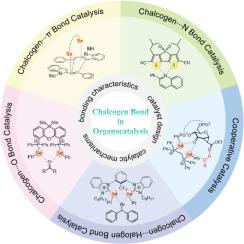Chalcogen bond in organocatalysis: bonding characteristics, catalytic mechanisms, and catalyst design
IF 23.5
1区 化学
Q1 CHEMISTRY, INORGANIC & NUCLEAR
引用次数: 0
Abstract
The chalcogen bond, as an important noncovalent interaction, has garnered significant attention in organocatalysis due to its environmentally friendly, low-cost, excellent catalytic performance, and mild reaction conditions. The chalcogen bond is an attractive interaction between an electrophilic region (namely σ-hole) of a chalcogen atom and a nucleophilic region in another or the same molecule. The chalcogen-based σ-hole interaction is the driving force for chalcogen bond catalysis, which has facilitated a range of organic reactions, providing a novel platform for addressing reactivity and selectivity in complex transformations. In this review, by integrating relevant experimental findings and our own theoretical studies, we focus on the application of chalcogen bonds in organocatalysis—covering aspects from bonding characteristics and catalytic mechanisms to catalyst design. In light of the types of chalcogen bond driving force, we present chalcogen⋯N bond catalysis, chalcogen⋯O bond catalysis, chalcogen⋯halogen bond catalysis, chalcogen⋯π bond catalysis, and cooperative catalysis of the other noncovalent interactions. In addition, we summarize some challenges and outlook, and hope to stimulate further exploration of chalcogen bonds in organocatalysis.

有机催化中的硫键:键合特性、催化机制和催化剂设计
硫键作为一种重要的非共价相互作用,由于其环境友好、成本低、催化性能优异、反应条件温和等优点,在有机催化领域受到了广泛的关注。硫键是指一个硫原子的亲电区(即σ空穴)与另一个或同一分子中的亲核区之间的相互吸引作用。以硫为基础的σ-空穴相互作用是硫键催化的驱动力,它促进了一系列有机反应,为研究复杂转化的反应性和选择性提供了一个新的平台。本文结合相关实验结果和自身的理论研究,重点介绍了硫键在有机催化中的应用,从键合特性、催化机理到催化剂设计等方面进行了综述。根据碳键驱动力的类型,我们提出了碳⋯N键催化、碳⋯O键催化、碳⋯卤素键催化、碳⋯π键催化,以及其他非共价相互作用的协同催化。此外,我们总结了一些挑战和展望,希望能激发对有机催化中硫键的进一步探索。
本文章由计算机程序翻译,如有差异,请以英文原文为准。
求助全文
约1分钟内获得全文
求助全文
来源期刊

Coordination Chemistry Reviews
化学-无机化学与核化学
CiteScore
34.30
自引率
5.30%
发文量
457
审稿时长
54 days
期刊介绍:
Coordination Chemistry Reviews offers rapid publication of review articles on current and significant topics in coordination chemistry, encompassing organometallic, supramolecular, theoretical, and bioinorganic chemistry. It also covers catalysis, materials chemistry, and metal-organic frameworks from a coordination chemistry perspective. Reviews summarize recent developments or discuss specific techniques, welcoming contributions from both established and emerging researchers.
The journal releases special issues on timely subjects, including those featuring contributions from specific regions or conferences. Occasional full-length book articles are also featured. Additionally, special volumes cover annual reviews of main group chemistry, transition metal group chemistry, and organometallic chemistry. These comprehensive reviews are vital resources for those engaged in coordination chemistry, further establishing Coordination Chemistry Reviews as a hub for insightful surveys in inorganic and physical inorganic chemistry.
 求助内容:
求助内容: 应助结果提醒方式:
应助结果提醒方式:


